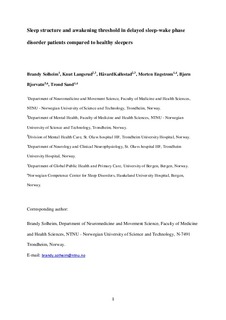| dc.contributor.author | Solheim, Brandy | |
| dc.contributor.author | Langsrud, Knut | |
| dc.contributor.author | Kallestad, Håvard | |
| dc.contributor.author | Engstrøm, Morten | |
| dc.contributor.author | Bjorvatn, Bjørn | |
| dc.contributor.author | Sand, Trond | |
| dc.date.accessioned | 2019-05-02T13:06:57Z | |
| dc.date.available | 2019-05-02T13:06:57Z | |
| dc.date.created | 2018-05-29T19:30:34Z | |
| dc.date.issued | 2018 | |
| dc.identifier.citation | Sleep Medicine. 2018, 46 61-68. | nb_NO |
| dc.identifier.issn | 1389-9457 | |
| dc.identifier.uri | http://hdl.handle.net/11250/2596338 | |
| dc.description.abstract | Study Objectives
Difficult early morning awakening is a primary symptom of delayed sleep-wake phase disorder (DSWPD), however, it remains poorly investigated. Our main objective was to quantify the awakening threshold in DSWPD-patients and healthy controls as well as investigate a possible relationship with sleep stages. A secondary objective was to compare habitual sleep measured by polysomnography and actigraphy between patients and controls.
Methods
Twenty DSWPD patients and 16 controls had two polysomnographic recordings at a sleep laboratory. Participants followed their habitual sleep-wake schedule on the first night and a forced sleep-wake schedule (00:00–07:00 h) on the second night. We used a custom-made alarm clock was for the forced-night awakening, starting at 72 dB sound intensity which increased up to 104 dB.
Results
Mean awakening threshold in dB was higher in patients compared to controls; 75.5 vs. 72.6, p = 0.01, and the difference could not be explained statistically by sleep-time. Patients who were in REM sleep upon attempted awakening had a higher awakening threshold compared to patients who were in NREM sleep; 80.0 vs 74.7, F = 6.4, p = 0.02. Patients had increased sleep onset latency both at home with actigraphy and by PSG during the first laboratory night (20.6 vs 12.1 min, p = 0.004), however no further differences between the groups were observed regarding sleep structure.
Conclusions
A high early-morning forced awakening threshold in DSWPD was related to REM sleep. Sleep onset problems, even with habitual bedtimes, may also be an integral feature of DSWPD. | nb_NO |
| dc.language.iso | eng | nb_NO |
| dc.publisher | Elsevier | nb_NO |
| dc.title | Sleep structure and awakening threshold in delayed sleep-wake phase disorder patients compared to healthy sleepers | nb_NO |
| dc.type | Journal article | nb_NO |
| dc.type | Peer reviewed | nb_NO |
| dc.description.version | acceptedVersion | nb_NO |
| dc.source.pagenumber | 61-68 | nb_NO |
| dc.source.volume | 46 | nb_NO |
| dc.source.journal | Sleep Medicine | nb_NO |
| dc.identifier.doi | 10.1016/j.sleep.2018.03.001 | |
| dc.identifier.cristin | 1587528 | |
| dc.description.localcode | © 2018. This is the authors’ accepted and refereed manuscript to the article. This manuscript version is made available under the CC-BY-NC-ND 4.0 license http://creativecommons.org/licenses/by-nc-nd/4.0/ | nb_NO |
| cristin.unitcode | 194,65,30,0 | |
| cristin.unitcode | 194,65,35,0 | |
| cristin.unitname | Institutt for nevromedisin og bevegelsesvitenskap | |
| cristin.unitname | Institutt for psykisk helse | |
| cristin.ispublished | true | |
| cristin.fulltext | preprint | |
| cristin.qualitycode | 1 | |
